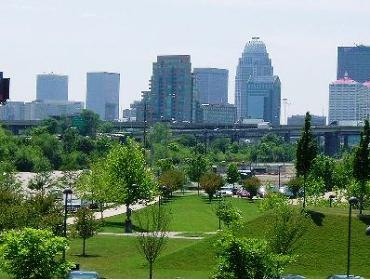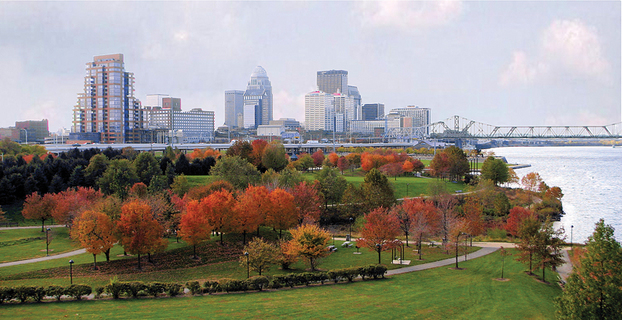Louisville Waterfront Park - Louisville, KY
Louisville Waterfront Park lies on the banks of the Ohio River adjacent to downtown Louisville, the largest city in Kentucky. It provides valuable public access to the river as well as allowing for a substantial green space in the heart of the city. Created in 1999, it is a relatively new park that is the result of a redevelopment effort by the city in its urban core. The park is a successful re-creation of an area of the city that had fallen into under-use and was characterized by blight. It is one of the prime examples of a growing trend of turning abandoned or blighted areas in cities into public space or parkland.
Before the existence of the park, the site was home to various types of industrial use. It was home to the wharf area where Louisville first established its economy along the Ohio. Over time, various uses developed including scrap yards, rail lines, and sand pits. By the middle of the twentieth century, the wharf had been largely abandoned of productive economic use and was largely abandoned. This coincided with the rise of the age of the automobile and road and highway construction. Elevated highways, specifically Interstate 64 and its junction with I-65, were constructed right through the heart of the waterfront. It severely limited access to and traffic within the area. The character of the area transitioned over time to parking lots and under-used structures, severely limiting its economic output and public access to the river. However, efforts were continuously being made to redevelop the waterfront and turn it into a desirable area marked by public space.
The result of numerous efforts and partnerships is the 85 acre park that exists today. The park opened in three separate phases between 1999 and 2009 as a result of a substantial public-private partnership. What was once a blight on the urban core of Kentucky's largest city is now home to massive green space and path and trails that wind throughout. Most importantly, the implementation of the park has granted the public unprecedented access to the shores of the Ohio River and the grand views and recreation opportunities that it affords. Many design features have been implemented as well including fountains, gardens, and spaces for large public events. The park has also become the most heavily used in the city, and is home to many festivals and concerts, particularly during the summer. The interstate system still runs through the park, but it has successfully developed underneath it to the best of its abilities.
Louisville is a city that has changed its economic character over time, which is fairly typical of midwestern and northern waterfront cities. However, the city decided to adapt with the changing times and convert under-used historical industrial sites into public park space. As a result, the area surrounding the park has experienced a recent economic revitalization as people are returning to the downtown area. A main catalyst for this return has been the draw of the new publicly accessible waterfront.
Before the existence of the park, the site was home to various types of industrial use. It was home to the wharf area where Louisville first established its economy along the Ohio. Over time, various uses developed including scrap yards, rail lines, and sand pits. By the middle of the twentieth century, the wharf had been largely abandoned of productive economic use and was largely abandoned. This coincided with the rise of the age of the automobile and road and highway construction. Elevated highways, specifically Interstate 64 and its junction with I-65, were constructed right through the heart of the waterfront. It severely limited access to and traffic within the area. The character of the area transitioned over time to parking lots and under-used structures, severely limiting its economic output and public access to the river. However, efforts were continuously being made to redevelop the waterfront and turn it into a desirable area marked by public space.
The result of numerous efforts and partnerships is the 85 acre park that exists today. The park opened in three separate phases between 1999 and 2009 as a result of a substantial public-private partnership. What was once a blight on the urban core of Kentucky's largest city is now home to massive green space and path and trails that wind throughout. Most importantly, the implementation of the park has granted the public unprecedented access to the shores of the Ohio River and the grand views and recreation opportunities that it affords. Many design features have been implemented as well including fountains, gardens, and spaces for large public events. The park has also become the most heavily used in the city, and is home to many festivals and concerts, particularly during the summer. The interstate system still runs through the park, but it has successfully developed underneath it to the best of its abilities.
Louisville is a city that has changed its economic character over time, which is fairly typical of midwestern and northern waterfront cities. However, the city decided to adapt with the changing times and convert under-used historical industrial sites into public park space. As a result, the area surrounding the park has experienced a recent economic revitalization as people are returning to the downtown area. A main catalyst for this return has been the draw of the new publicly accessible waterfront.


